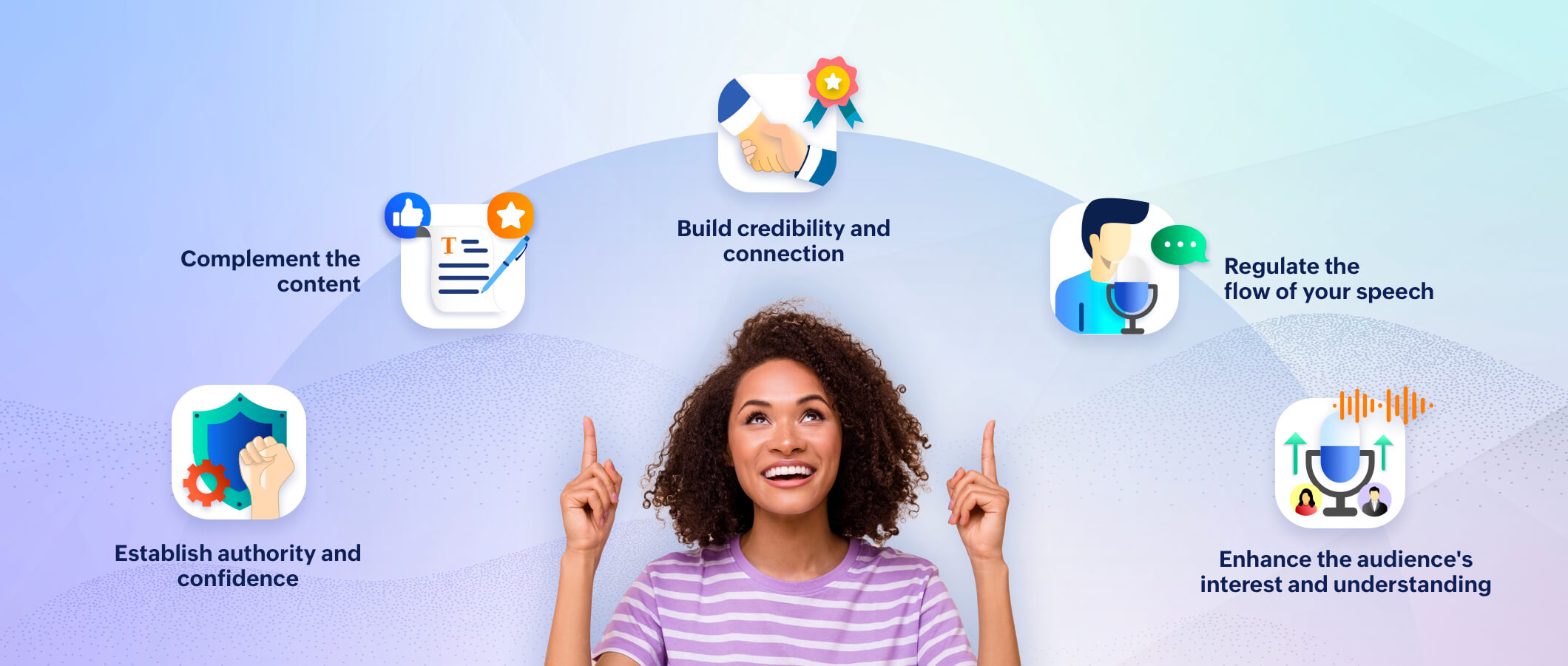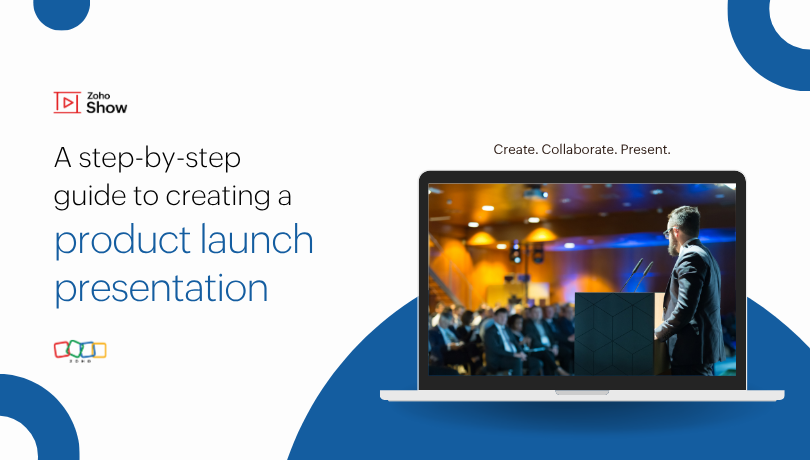- HOME
- Design & deliver
- Mastering nonverbal communication in public speaking: A detailed guide
Mastering nonverbal communication in public speaking: A detailed guide
- Last Updated : February 21, 2024
- 1.9K Views
- 7 Min Read

Stay calm
Correct your posture
Maintain eye contact with your audience
Control your facial expressions
Move around the stage
You've probably heard these tips before.
Ask any expert presenter for public speaking tips, and these would most likely be at the top of the list.
Communication is definitely the key, but nonverbal communication plays an important role in public speaking. Everything about how you stand, smile, or move has an impact. In short, a speaker is judged even before they speak. Hence the importance for nonverbal communication.
What is nonverbal communication?
Nonverbal communication includes the transfer of information without the use of words- written or spoken. This communication is generally through gestures, body language, and any other components that shape your message without words. Your nonverbal communication should align with the content of your message to build trust with your audience.
Types of nonverbal communication
There are different types of nonverbal communication that we use everyday.
Let's discuss the ones that hold relevance to public speaking.
Kinesics
Derived from the word "kinesis", kinesics means movement and refers to the interpretation of body communication. Universally called as body language, includes facial expressions, posture, eye contact, gestures, and other body movement.
Facial expressions
If there is something that most of us can not control, it's how our face communicates. It is important to remember that while your audience can notice your are excitement, they will know if you are nervous. So it is only fair to adjust your facial expressions according to what you are saying. For example, you might raise your eyebrows when revealing a surprising piece of information. The feeling will resonate more with the audience and help them follow your narrative.
Eye contact
Ask any expert for their go-to tip to connect with a listener, and the immediate response will be to maintain eye contact. This will help you establish authority and confidence. Also, this makes your audience hold attention to you and get involved in the speech. While making eye contact, ensure to pause and look at them rather than just scanning.
Gestures
Moving your hands is a way of expressing yourself. By nature, humans are used to making gestures while we talk, but remember that some gestures might not be acceptable across cultures. You can even practice hand gestures in front of a mirror to see how you'll look to an audience
Body movements
When you are nervous, don't freeze, MOVE! Movement helps maintain an image of confidence and prevent the audience from getting bored. When you move around the stage, you can feel the audience's gaze following you, ensuring that you have their attention. However, you must ensure that your movements look calm and natural. A purposeful body language will increase authenticity and support your message.
Posture
Hold your head high! Yes, you can be proud of yourself too. But take this quite literally. Posture is the way you position yourself. Standing straight holding your head high and chin up is considered a positive posture. Good posture can also help you project your voice and remain comfortable while speaking.
Chronemics
Chronemics is the study of how time affects nonverbal communication. Time is precious- whether it is yours or others. Time affects communication. Plan your speech carefully. Having a good sense of time not only leaves a positive impact on you but helps you in a lot of aspects.
When you arrive early to the venue, you have enough time to get accustomed to the surroundings and calm your nerves. Make sure you start your presentation on time; being punctual always puts you in a good light. Maintain an appropriate pace while speaking to ensure your audience can understand you. Finally, when you present as a team, make sure you give everyone enough time to shine.
Vocalics
Also known as paralanguage, Vocalics focuses on how you speak, including your tone, pitch, clarity, and rate of speech. Why is this important? Clarity of speech is directly proportional to the way your idea is convey your ideas to the audience. The way you speak gives your listeners the confidence that you know what you are talking about.
The purpose of a presentation is to inform, persuade, or inspire. Your voice will assist majorly with it. That is why practicing your speaking style is as important as putting together your content or deck for the presentation. When you are nervous or forget to say something, your tone might make it more prominent. Voice conveys emotion, and developing better control over it can improve your public speaking significantly.
Artifactics
Appearances create impressions. How you present yourself will definitely matter to your audience. Artifactics, also called objectics, is the study of clothing. It is essential to dress appropriately for the speech as it conveys your personality, authority, and confidence. This type of nonverbal cue should be used to communicate professionalism and build credibility among your audience.
What you wear to a speech largely depends on your audience as attires vary according to cultural setting. Certain colors and styles might be acceptable in one culture and inappropriate in another.
Haptics
Haptics is another type of nonverbal communication that involves touch. Largely useful in interpersonal communication, this type of nonverbal cue works when you present to smaller groups or in one-on-one interactions. However, even when you're speaking before a large audience, there may be opportunities for handshakes, shoulder pats, or even high-fives (in an informal setting) as you take the stage or after your presentation.
Touch conveys emotions, but it can be positive or negative. A firm handshake can establish trust and credibility. This type of nonverbal cue is audience-specific. Always remember to be respectful of people's personal space and boundaries.
Why is nonverbal communication important in public speaking?
Albert Mehrabian's 7-38-55 rule states that communication is 7% verbal, 38% through tone of voice, and 55% body language. While the majority of us spend time on what we are going to present, this rule emphasizes that how we present is more important.

Complement the content
Actions speak louder than words, they say. When your body language is aligned with what you say, it ensures that the listeners understand your intentions. For example, you might adjust your tone of voice to express what you say. An excitement when you are discussing your company's increase in revenue will have your audience infer the same emotion.
Build credibility and connection
Your audience needs to trust you to believe in what you are saying. This is why it's important to make eye contact and use appropriate gestures to establish rapport. Acknowledging your listeners and making them feel involved will encourage them to stay engaged with your speech or presentation.
Establish authority and confidence
A positive personality oozes confidence. Appropriate attire that aligns with your audience, straight posture, a firm handshake, and steady eye contact are considered positive expressions of body language. These help develop your authority and strengthen the authenticity of your message.
Enhance the audience's interest and understanding
Nonverbal cues help avoid the monotony of a long speech and keep the audience's interest. When the speaker uses gestures and moves around the stage, it creates curiosity among the audience, and they tend to observe more. Aligning the verbal and nonverbal aspects of your performance improves the overall cohesiveness of your message and facilitates clear communication.
Regulate the flow of your speech or conversation
Gestures, changes in body posture, and facial expressions act as signals to control the flow of the conversation. This will help the audience understand when you start, stop, or pause in between your speech and react appropriately if the setting is more conversational.
Tips to improve nonverbal communication
Know your audience
The most effective nonverbal communication is specific to the audience and context. Ideally, you should consider your audience before the speech and determine the most appropriate nonverbal cues to use. Cultural and social norms around clothes, gestures, and interactions are highly variable, so it is important to adapt according to your audience.
Align with your verbal cues
Align your gestures or movements with your words and slides to enhance the visual appeal of your presentation. Also, you can control the timing of your nonverbal cues to coincide with your verbal message.
Keep practicing
The golden rule is to practice until you are perfect. Practice in front of a mirror or record yourself to identify unintentional gestures and movements and learn to control or avoid them. This will help you refine your body language.
Control nervousness
There are a few things we repeatedly do when we get nervous, like fidgeting or using filler words. Nervousness can impact your nonverbal cues, so be as relaxed as possible to avoid distracting the audience.
Embrace feedback and self reflection
There is always room for improvement. Your audience's reaction is an important source of feedback you can be spontaneous to guide adjustments to your body language or tone. After the session, ask for input from colleagues. If the session was recorded, reviewing your performance can also help you identify opportunities for improvement and track your progress.
Final thoughts

Glossophobia, the fear of public speaking, is considered the most common fear in the world. Stage fright is real, and every time you are nervous before a speech, it explicitly shows to the audience. Public speaking is a skill that can be mastered over time, and practicing nonverbal communication is a shortcut to conquer it.
Also, the duty of a speaker is to keep the audience engrossed in their speech, and words can not simply do it. Communication combined with nonverbal combination is the perfect recipe for a successful presentation.
Happy Presenting!



Comments(1)
It's good